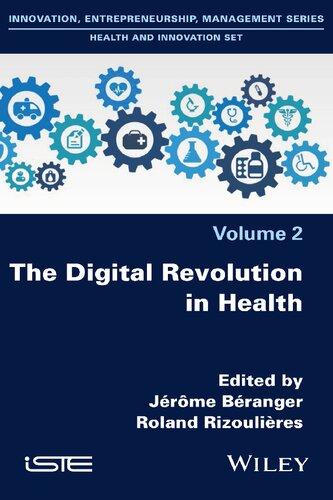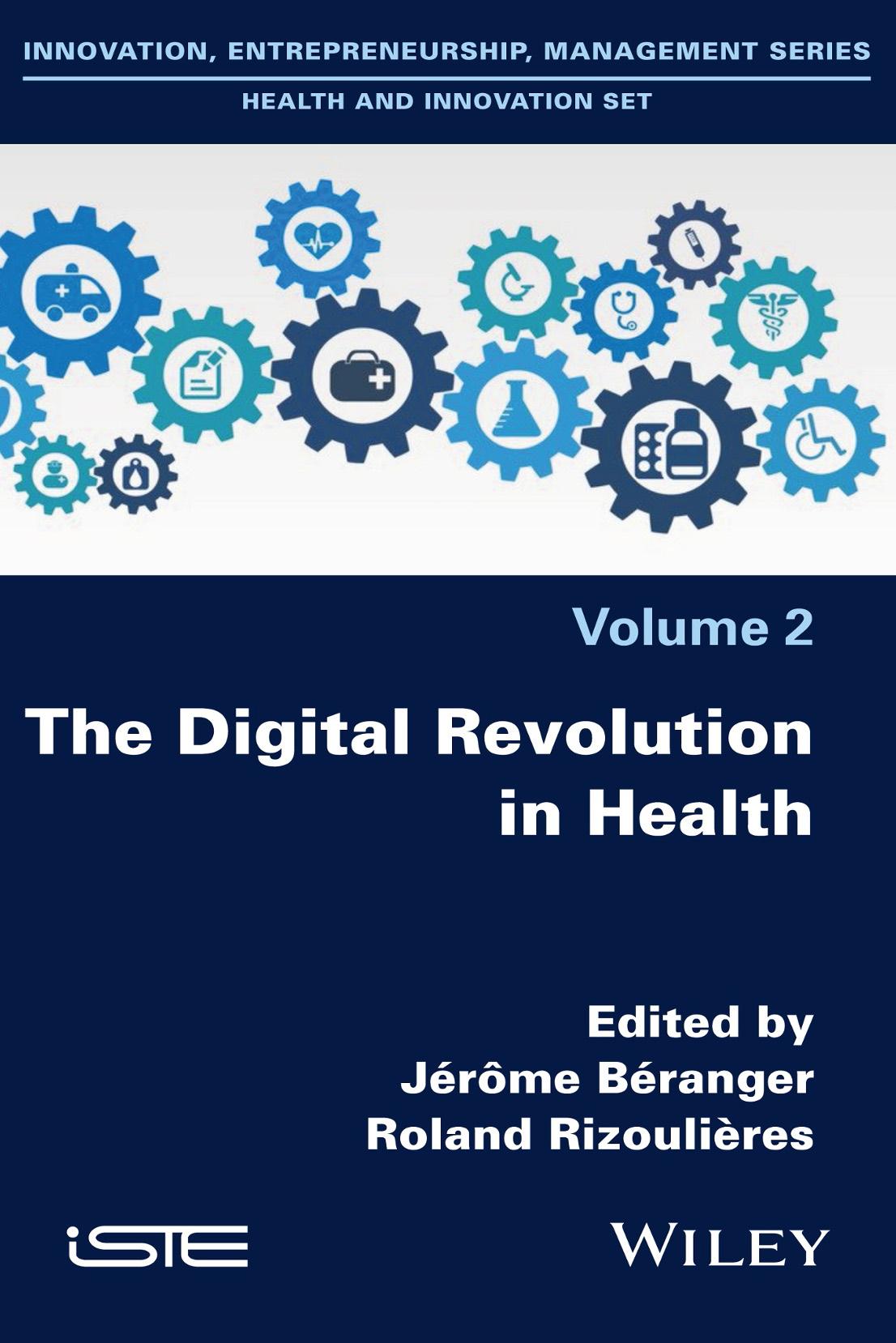The Digital Revolution in Health
Edited by
Béranger
Roland Rizoulières
Jérôme
First published 2021 in Great Britain and the United States by ISTE Ltd and John Wiley & Sons, Inc.
Apart from any fair dealing for the purposes of research or private study, or criticism or review, as permitted under the Copyright, Designs and Patents Act 1988, this publication may only be reproduced, stored or transmitted, in any form or by any means, with the prior permission in writing of the publishers, or in the case of reprographic reproduction in accordance with the terms and licenses issued by the CLA. Enquiries concerning reproduction outside these terms should be sent to the publishers at the undermentioned address:
ISTE Ltd
John Wiley & Sons, Inc.
27-37 St George’s Road 111 River Street London SW19 4EU Hoboken, NJ 07030
UK USA
www.iste.co.uk
www.wiley.com
© ISTE Ltd 2021
The rights of Jérôme Béranger and Roland Rizoulières to be identified as the authors of this work have been asserted by them in accordance with the Copyright, Designs and Patents Act 1988.
Library of Congress Control Number: 2021932939
British Library Cataloguing-in-Publication Data
A CIP record for this book is available from the British Library
ISBN 978-1-78630-695-1
1.3. Digital technology as a challenge for territorial integration in the context of healthcare in France .......................
1.3.1. Healthcare territories: starting from the patient-user rather than from the offer of health and medico-social actors? ...........
1.3.2. An exemplary structuring of the territory? The TSN program and the E-Parcours ...........................
1.3.3. What lessons can be learned?
1.3.4. PTAs and CPTS: the Alpha and Omega of healthcare territory structuring?
1.3.5. Launch of SNAC in
1.4. Digital integration and aging in France: from health pathway to life pathway
1.6.
Chapter 2. Digital Technology in a Cancer Patient’s
2.1.
2.2.
2.4.
2.5.
2.6.
2.7.
2.7.1.
2.7.2.
2.8.
2.8.1.
2.8.2.
2.8.3.
2.9.
2.10.
Valentin BERTHOU
3.1.
3.1.1.
3.1.2.
3.2.
3.2.1.
3.2.2.
3.3.
3.3.1.
3.3.2. What theoretical framework for dealing with complex situations?
3.4.
3.4.1.
3.4.2.
3.4.3.
3.4.4.
3.5.
3.6.
Chapter 4. Use of AI Systems in the Care Relationship, Redefining Patient and Physician
Anthéa SÉRAFIN
4.1. Progressive affirmation of individualized healthcare in the service of patient autonomy
4.1.1. Reinforcing the patient’s responsibility in the healthcare relationship
4.1.2. Increasingly personalized
4.2. Integration of digital and ethical concepts in the training of health personnel and in the education of citizens
4.2.1. Global challenge of developing citizens’ digital skills
4.2.2. Issues specific to the training of healthcare
4.3.
Chapter 5. Artificial Intelligence Ethics in Medicine
Loïc ÉTIENNE
5.1. Artificial
5.2.
5.3.
5.4.
5.5.
5.6.
5.7.
5.8.
Chapter
Alpha Ahmadou DIALLO
6.1.
6.2.
6.3.
6.4.
6.5.
6.6.
6.7.
Chapter
7.1.
7.1.1.
7.2.
7.2.1.
7.3.1.
7.3.2.
7.4.
7.5.
8.4.
8.5.
8.6.
8.7.
8.8.
Lina
WILLIATTE
9.1. Introduction
9.2. Telehealth: a different adoption depending on the country ........
9.2.1. A word with different meanings in different countries ........
9.2.2. E-health: a service provision
9.3. Standard applicable to data ...........................
9.3.1. General framework .............................
9.3.2. Rights of the data subject: founding principles of personal data processing .............................
9.3.3. The accountability principle
9.4. Conclusion
9.5. References
Advocacy for a European Reference Framework for Digital Ethics
When inventing the binary code 170 years ago, human beings certainly did not imagine that they would themselves become a sequence of 0s and 1s. Today, algorithms are omnipresent, intrusive, and have no qualms about entering people’s intimacy. This digital transformation then introduces a change in contextual reference points and perspectives focused on information and its potential for financial valuation.
Consequently, these technological innovations irremediably lead to ethical and moral questions relating to appropriateness, security, nondiscrimination, free will, confidentiality, bias, and autonomy in relation to human beings. Under these conditions, we are convinced that in order to understand and accompany this digital revolution, we must reason in transversality – in continuum – and not in a silo, because everything is articulated and interwoven within a sociotechnological system. It is at this point that an ethical approach takes on its full meaning!
Since the Enlightenment and the emergence of the Encyclopedia, human civilizations have tended to separate and isolate, if not to compare, the exact sciences (mathematics, physics, chemistry, etc.) and the humanities and social sciences (HSS; philosophy, sociology, anthropology, etc.). Today, when HSS specialists think and talk about a digital world that escapes them, former scientific experts are developing technical innovations without really being aware of their impact and consequences on society. In our opinion, the main weakness relative to the digital word lies there!
Consequently, without a decisive and modern contribution from the scientific community, this amounts to leaving the question of the meaning, legitimacy, and responsibility of digital systems only to a few predominant market players who do not have the vocation or quality to think about the good of humanity. The great thinkers of another time like Plato, Pascal, Aristotle, or Descartes, who were at the same time great scientists and philosophers, no longer exist! Now, the scientific philosopher has become an endangered species, or is even already extinct. In this period that gives up thinking globally and simultaneously about innovation, technology, and meaning, it seems essential to (re)educate, train, and orient scientists towards HSS in order to open them to fundamental reflections for the well-being of our contemporary society, and philosophers towards the exact sciences to improve their knowledge of a digital humanity.
If you think about it, to have a well-structured ethical reasoning, you have to be Cartesian and rigorous from a methodological and architectural point of view. Under these conditions, half a millennium after the last great multidisciplinary intellectuals such as François Rabelais (“science without conscience is but the ruin of the soul”) and Leonardo da Vinci (“to do in order to think and to think in order to do”) we can see that their maxims are more topical than ever. It therefore seems clear that we must strive to return to a transversal and holistic perception in order to answer the following question: How should we approach the world today and in the future?
Pluridisciplinarity and coordination must once again be the key to success in the face of hyper-specialization due in large part to globalization and international competition, in order to accompany and strengthen this digital humanity that is looming on the horizon. It is, therefore, necessary to succeed in marrying the digital and the ethical, by establishing a bridge between the two until they are no longer distinct. The “and” becomes the “is”. This approach, centered on Ethics by Design (from the design stage), will enable us to provide a positive and fearless framework for the technological innovation at the heart of its genesis. In this context, it seems essential to set up a European reference framework for digital ethics in order to establish a common base of responsibilities, awareness, and simple actions relating to the socio-ecological impact of digital technology. This shared repository would then be composed of principles, rules, and ethical recommendations whose objective would be to bring confidence to citizens in the face of the expansion of digital technology.
Finally, a few centuries after the European cultural movement leading to the emergence of the Enlightenment, which proposed to overcome obscurantism and promote knowledge, Europe could once again be the initiator of a new, more transversal vision and standardization approach to digital transformation, the watchword of which could be – on this 500th anniversary – “digital technology without ethics is nothing but the ruin of humanity”. This digital revolution would then enter a century that could be called the century of “Intelligences”. Moreover, when you think about it, “being a beacon” does indeed mean “being intelligent”!
Dominique PON
Director of the Clinique Pasteur, Toulouse
In charge of the government’s digital worksite for the Ma santé 2022 plan
Stéphane OUSTRIC
General Practitioner and University Professor President of the Departmental Council of the Haute-Garonne Medical Association
National Delegate for Health and Digital Data for the CNOM
Jérôme BÉRANGER
Founder of ADELIAA (Algorithm Data Ethics Label) Researcher (PhD) associated with Inserm 1027
BIOETHICS Team – University of Toulouse 3
March 2021
Acknowledgements
To our friend Corinne Grenier, without whom this confluence would not have been possible; to her listening and her great professionalism.
Also, a big thank you to our co-authors for their expertise and finesse of analysis on their respective themes.
Finally, thank you to our loved ones for their patience in this time spent away from them writing and exchanging on this exciting topic.
Digital technologies are supporting the changes in our healthcare system (mainly the aging of the population and the sharp increase in chronic diseases) and sometimes bring about major changes in the organization and functioning of our healthcare system, particularly in the processing of health data (artificial intelligence). Not only do they make it possible to modernize current organizations, but also to imagine radically new practices (diagnosis, prevention, therapeutic education).
The main events in digital health technologies involve computerization, digitization, and technical networking involving management, organization, and delivery of care and services. Technological advances have made it possible to process, store, and disseminate information in all its forms – oral, written, or visual – increasingly freeing us from any fear of distance, volume, and time. Initiated in most industrial countries since the early 1990s, the implementation of information and communication technologies (ICTs) is increasingly supporting the various transformations taking place in the field of health.
In less than two decades, the Internet and mobile telephony have revolutionized our modes of communication. The healthcare sector is now facing a major change, fueled by the explosion of knowledge in biomedical sciences, biomechanics, nanotechnology, “cyborgization”1, clinical applications, and the standardization of certain technologies like genome
Introduction written by Jérôme BÉRANGER and Roland RIZOULIÈRES.
1 This term refers to the implementation of neuroprosthetics in the patient’s body to combat neurodegeneration or tetraplegia.
sequencing. The health data produced, collected, and stored throughout the patient’s care pathway are now massive. Big Data are increasingly feeding the medical “data-sphere”. Coupled with the progress made in ICT2, this evolution around these large volumes of data is set to become a revolution.
We are now entering the era of medicine “4.0” based on Big Data, algorithms, blockchain, self-learning expert systems, and artificial intelligence (AI) to move towards a more individualized, personalized, and predictive medicine. Big Data from connected devices and tools of all kinds and interpreted by expert systems can only be managed by machines that, thanks to AI, can communicate with each other and create new ways to serve humans. This new medicine follows the medicine Hippocratic3 (a singular physician-patient symposium) of Antiquity, medicine 2.0 (medical forums via the Internet)4, and medicine 3.0 (health applications on smartphones and connected devices) of the 2000s. Since then, healthcare professionals and patients are always on the lookout for information on the pathologies observed, treatments, and care to be provided or on preventive actions. To do so, they still mainly use websites to inform and educate themselves. We are seeing the emergence of communities of patients as well as more and more healthcare professionals via community platforms (mono or multi-specialty) and active groups on open social networks such as Twitter, Facebook, and LinkedIn. For healthcare institutions, the Web is becoming an indispensable tool in the relationship with patients. This involves tools and services on their websites and an increased presence on social media such as YouTube, Twitter or Facebook. These communities of healthcare professionals promote sharing between colleagues and peers, particularly of clinical cases or expertise, multidisciplinary collaboration, etc. Thus, this digital technology is an opportunity to develop less traumatic and expensive medicine and much more preventive, participative, and personalized medicine.
2 Cloud computing, search engines, data mining techniques, Very Large Database, datacenters, Open Data, indexing robots, multi-agent systems for automatic data indexing, CRM (Customer Relationship Management), profiling and innovative approaches to data acquisition, semantic web tools, connected devices, bioinformatics, biometric devices, computational nanotechnologies represent essential elements on which Big Data relies.
3 Note that in the Hippocratic Oath, the text invites doctors to practice their profession with the best knowledge of the technologies of their time.
4 The doctor-patient couple is subject to the interaction of society as a whole (other patients, other health professionals as well as insurers and political power). From that moment on, the singular colloquium became plural. But it is always human beings who interact with each other using digital means as a medium.
This new digital world is constantly studying the real world with the aim of creating predictability and predictability. This connected medicine provides a better understanding of both infectious and chronic diseases at the population level, innovative approaches to patient diagnosis and treatment, improved research into diseases and their therapeutics, and optimized monitoring of diseases and risk factors. Under these conditions, the range of possibilities is considerable, and we can only glimpse today the major changes generated by the advent of digital technology in healthcare. This convergence between technological innovation and scientific research, between digital technology, mathematics, and medical progress, will have direct repercussions on medical practice and the doctor-patient relationship, which until now has been based mainly on the medical act. Thus, this information technology has a profound effect on social relationships, human beliefs and the very nature of knowledge. It is transforming the practice of medicine. From now on, medical communication no longer consists only of delivering a precise diagnosis, but also in evaluating all the interactions implemented by patients and the systems that accompany them (family, social environment, caregivers). Under these conditions, the meaning of medical information is considered to be an object of sharing and exchange at the crossroads of relationships and patient management processes.
The objective is neither to put these ICTs on trial in the doctor-patient relationship, nor to make the slightest value judgment on the subject, but rather to identify the issues and limitations, so that they do not become more harmful to the healthcare user than they will be beneficial to him or her. Thus, the performance and possibilities of technologies related to medical information raise new problems for health professionals of a judicial, medical, and reparational nature related to new requirements for the legitimacy of the right to information, causing a certain disorganization and upheaval in the doctor-patient relationship. In addition, there is a real awareness and ethical questioning of confidentiality, the right and freedom of access, security, accountability, free will, autonomy, and medical secrecy that surround the use of medical information via ICTs. Finally, there is the advantage of greater ease of interpersonal communication and medical performance for some, greater uncertainty about security, confidentiality, accessibility, medical data protection, and social justice for others; this digital medicine leaves no one indifferent!
Therefore, this book leads us to question this digital revolution within the healthcare system. What are the challenges, the stakes, and the integration of this digitization of medicine in the healthcare system (Part 1)? What are the repercussions and consequences of this digital medicine on the mentalities and social values of the digital actors in the relationships between professionals and patients (Part 2)? Finally, one of the major questions raised by this book is how the technological modernization of the use of digital data can be accompanied by an ethical-legal awareness of the actors of the health system (Part 3).
I.1. The health system and digital technology: challenges, issues, and transformations (Part 1)
The public authorities and the private sector (particularly the insurance and mutual insurance sectors) have a normative and financial position. As such, they have the legitimacy to support creativity and digital innovations in health. They can frame and encourage this movement. However, for too long, good ideas and innovations have remained confined to the services, institutions, or local networks that gave birth to them, generating compartmentalization and incompatibilities that are harmful to a controlled “urbanization” of information and management systems. Our healthcare system needs these innovations in order to overcome the difficulties of coordination between professionals, to cope with a growing proportion of elderly people at home or in institutions and patients with chronic diseases as well as to enable citizens and patients to be more involved in their care.
Paradoxically, healthcare professionals have a great many digital tools and services at their disposal in their daily practice, whether for patient care or administrative management. As these tools are offered by various institutional and private players on geographical scales that are sometimes inconsistent with the health and life paths of patients, the result is a lack of transmission of patient data to coordinate the process. And the coordinator does not always exist, or perhaps very little, except for complex cases, with the added bonus of remuneration that is poorly adapted (lack of patient packages or pathologies). Above all, however, the practice comes up against fragmented and often poorly interoperable application frameworks. Thus, each use often corresponds to a tool, which greatly complicates daily professional practice. This phenomenon means that the most basic expectations and needs of healthcare professionals (medical and
paramedical) are not met or are met in too fragmented a manner: information exchanges between individuals around a patient, coordination of professionals, exhaustiveness of information available on care pathways, simplification of administrative procedures.
These phenomena are described on several fields of analysis and experiences in the first part. The institutional approach and the experience of the authors shed light on the dysfunctions and the creative organizational tinkering that the actors operate.
I.2. The digital and transformations in the relations between professionals and patients (Part 2)
Traditionally, the healthcare system places the consumer/patient as an object of care provided by professionals, the “knowers”. The consumer/patient is often reduced to a passive role in the construction of their care pathway and has extremely little control over the use of their health data. In addition, users currently have only a very limited panel of digital health services compared to the uses they can develop in other sectors. The digital shift in health, as defined by the WHO, must therefore have the essential objective of repositioning users as the primary beneficiary of digital health services by giving them the means to be a real player in their own health.
Moreover, while health concerns all citizens, the ethical framework within which digital health must be used remains unclear. The interests and limits of the use of digital technology in health deserve to be explored in greater depth.
Finally, the ethical dimension in the use of digital technology in health is explored in the specific context of the development and promotion of public health in West Africa, particularly with epidemics such as Ebola.
I.3. Supporting digital health (Part 3)
Innovation, whatever its form (technical, organizational, etc.), implies an organization of uses upstream and downstream of the implementation of innovation. However, the modes of production and dissemination of innovation in digital health are being overturned by new practices between
players, shedding light on support and governance methods that encourage their success, create difficulties in disseminating them, or block them.
On the one hand, digital healthcare support must deal with new approaches to innovation in the public sector, particularly innovation approaches open to new actors and collaborations, which consist of mobilizing the resources, expertise, and knowledge of a variety of actors to discover, develop, and implement new ideas. The quality of the innovation is then potentially enriched by the participation of this variety of actors, which gives rise to organizational innovations in terms of governance and management of relations between the players, taking into account their different identities and cultures. The construction of a common language and shared practices is an in-depth work, in perpetual movement and recomposition.
Moreover, the need to support digital healthcare has led to a redefinition of ethical governance and responsibility. The case of AI is shaking up codes and practices. Ethics must be addressed on the side of practitioners as well as users/patients.
Finally, the launch of digital technology in Europe highlights the fact that governance and the speed of development are not the same as in the Americas. The reason for this is certainly cultural, but also legal: a legislative framework that European countries have chosen to give themselves, which can be improved, but which has the merit of existing. For telehealth, the French concept is unique compared to that of other European neighbors, whereas for the processing and use of data, it is the European states that together have opted for a unique framework compared to the one launched in the United States. Moreover, this gives rise to major geopolitical conflicts over the use of health data and its appropriation by third parties outside the national/European territory.
Thus, these three parts illustrate the upheavals that are taking place as a result of the digital revolution in healthcare. In order to develop a transversal and ethical reflection, our book is based successively on the digital revolution, the “data-sphere” and its digital applications, the legal framework and ideas to move towards what can be called a “digital trust of society”. By highlighting a background framework based on ethical and technical reflection, this book aims to provide the first elements of an evolutionary path that will contribute to significant changes in mentalities and ways of
working, as well as strategic and organizational transformation, a transformation that must have a “human face” for this digital revolution in health, the goal being to find a certain coherence and meaning in this landscape of perpetual technological evolution. Technology cannot be a goal in itself, let alone in health. It must above all be oriented towards the patient, who is as much as possible at the center, and provide the best possible healthcare for the patient. Finally, the aim of this book is to raise awareness among all the players in the healthcare system and to promote a culture oriented towards involvement, appropriation, and responsibility in digital healthcare.
The Health System and Digital Technology: Challenges, Issues, and Transformations
The Digital Revolution in Health, First Edition. Edited by Jérôme Béranger and Roland Rizoulières. © ISTE Ltd 2021. Published by ISTE Ltd and John Wiley & Sons, Inc.
Digital Integration and Healthcare Pathways in the Territories
1.1. Introduction
At the beginning of March 2018, French ministry work on the “digital” project of the Stratégie de transformation du système de santé (STSS), on the theme “Accelerating the digital shift”, aimed to produce by the end of June 2018 an operational roadmap covering the 2018–2022 period and aimed at strengthening the digital shift in the health system. In the long term, however, digital technology is responding to two strong but unfinished challenges: better integration of healthcare and better coordination of care.
The management of patients is becoming more complex, in particular due to the increasing prevalence of chronic pathologies, the accumulation of co-morbidities, psychosocial problems, and the aging of the population (Perone et al. 2014; Huard 2018). The difficulty in applying the recommendations of practice guidelines for such complex patients has been shown; in fact, by combining health, social, and environmental issues, they have specific properties (Wilson et al. 2001; Waldvogel et al. 2012). Complex patients are complicated not only because of their multiple pathologies but also when their different problems intertwine and interact, creating a new situation that is more difficult to manage. It becomes a unique case for which interventions must be rethought (Boyd et al. 2012) and adapted not only to the specificities of the pathologies and above all to the priorities and resources of patients and their environment.
Chapter written by Roland RIZOULIÈRES
Digital Revolution in Health, First Edition. Edited by Jérôme Béranger and Roland Rizoulières.
Patient management in this context of epidemiological transition has been the subject of various conceptualizations, including the Chronic Care Model (CCM; Figure 1.1) proposed by Wagner et al. (1998) and Bodenheimer et al. (2002a, 2002b). In order to respond to the diversity of problems and the multiple skills required, these models recommend individualized care, requiring on the one hand an adapted healthcare system (Bodenheimer et al. 2009) and, on the other hand, a coordinated interdisciplinary approach (Schibli 2012; Gittel 2014).
Figure 1.1. Long-term chronic care model (Source: Perone et al. 2014). For a color version of this figure, see www.iste.co.uk/beranger/health.zip
The consequence of this integrated and coordinated approach is the need for digital tools on the territory to ensure exchanges between professionals and patients/caregivers. It is precisely on this point that our reflection focuses. However, while the digital revolution brings great changes, digital tools are primarily based on organizational changes and often reveal organizational difficulties rather than representing the “Holy Grail” for all our problems.
Integration of care can be defined as a set of techniques and organizational models implemented to enable the transmission of information, the adoption of common operating modes, and collaboration between the health, medical, and social sectors. It can intervene at the level of financing, the administrative organization of the territory, and the functioning of healthcare structures.
The immediate goal of integration is to reduce the fragmentation of medical and social services in order to facilitate patient access to services that meet their needs. Its longer-term goal is to enable better care outcomes and better use of health resources.
The Chronic Care Model (Wagner 1998) conceptualizes the totality of conditions that influence the quality of care for a chronically ill person: funding, policies, laws, training, communication systems, information, resources, etc. This model postulates that changes in these different areas will have an impact on the practice of caregivers and on the care of sick people.
It also suggests that changing practices at the caregiver level requires action at the overall health system level. It may thus prove relevant to act on the legislation surrounding the methods and conditions for financing services, on the communication systems available to enable caregivers to communicate with patients, on the organization of training systems, on the recognition of the usefulness of support structures offered to patients, etc. The report also suggests that, in order to change practices at the caregiver level, action must be taken at the global level of the health system. Furthermore, this model shows the importance of proactive and interdisciplinary teamwork.
It is part of a clearly collaborative perspective in which the person being cared for participates actively in their care.
Integration alone does not improve care outcomes. It must be combined with “case management” procedures, that is, the explicit identification with an individual, or a group, of coordination activities whose flexibility and workload are beyond the capacity of primary healthcare professionals in their daily practice.
We will look at how digital healthcare is helping to improve the health and life course of patients and their caregivers, while raising the organizational issues inherent in our historically siloed healthcare model.
1.2. What lessons can be learned from integrated American and Swiss models?
In general, the study of internationally integrated health systems is situated from the perspective of organizational critical analysis in the management of chronic diseases. Issues of efficiency and cost-effectiveness (cost containment) are the two main drivers. The digital issue generally remains in the background. However, as Christian Bourret (2003) points out, “in the United States, 30% of medical errors are said to be due to problems related to information processing, in particular patient identifiers. This shows the importance of health information and the extent to which its control, optimal use, and quality of data are at the heart of the evolution of health systems and the improvement of the quality of care.”
Jane Grimson et al. (2000) identify “the inability to share information across healthcare systems and organizations as one of the major barriers to care coordination and cost containment.” Some of the reasons for the limited or non-implementation of information technology in the health sector are the complexity of medical data, data entry problems, security and privacy issues, the lack of a unique national patient identifier in many countries, and a general lack of awareness of the benefits of information technology. Many models are experiencing these difficulties. Obviously, we cannot analyze them all in this chapter. We will focus on two of them: the HMO (Health Maintenance Organization) in the United States and the Swiss model of the Delta network (Huard and Schaller 2010a, 2010b, 2011a, 2011b). The HMO was chosen for its historical character and the Swiss model for its effectiveness in chronic disease management (Huard 2019).
1.2.1. The
cradle: the United States
The United States has been experimenting with integrated systems at least since the 1950s and has seen a significant evolution in the organization of its most familiar model, the HMO, since the 1990s. However, the HMO is
not the only model in the United States. Since the country has not historically had compulsory health insurance, it is the private sector that has strongly structured the health system. Obamacare has only partially changed this dominant state of affairs.
The other interesting model in the United States concerns the territorial structuring of medical homes in town medicine, the PCMH (Patient-Centered Medical Home). The reflection initiated on the management of chronic diseases based on the Chronic Care Model has been extended in the United States by focusing on the organization of primary care, which will allow us to better understand the notion of digital healthcare territory in the United States, a notion that is imperfectly covered by HMOs.
1.2.1.1. Evolution of health maintenance organizations: from managed care to disease management
We start with the oldest of these integrated models, embodied by HMOs. “HMOs have been in existence since the early 20th century in the United States and are partnerships between private insurers and healthcare providers. Initially, they offer a care pathway, financed by the associated insurance, and structured as a gatekeeping system: a general practitioner refers the patient, if necessary, to the hospital or to specialists in the network” (Parel 2016, p. 3). They developed from the 1973 HMO Act adopted by the Nixon administration (Gruber et al. 1988). The HMO Act led to the unprecedented development of Managed Care.
HMOs can be described as an integrated system of health maintenance, production of healthcare, and health insurance (Duhamel 2002):
– a health maintenance system: in this network paid by capitation, the insurer and the healthcare provider take full responsibility for the expenses of their members covered by the contract and, therefore, have every interest in keeping their clients as healthy as possible. Prevention and health education are important elements of the programs put in place and are considered long-term investments;
– an integrated care production system: for its subscribing population, the insurer is responsible for organizing access to care through a set of selected professionals (health professionals, providers employed or contracted by the insurer). Access to care is prioritized and coordinated. The group of physicians working for an HMO is multidisciplinary and organized into one or more medical centers, depending on the geographical area served. The
notion of healthcare territory is still rather fluid. The medical staff includes primary care physicians and specialist physicians. For less common specialties, the insurer establishes contracts with specialists either within or outside the network. The size of the structure varies considerably, ranging from 100 to 1,000 doctors. As a result, the insured party’s access to care is very strongly limited to network providers. Except in emergencies, if the insured party consults a doctor outside the HMO, he or she is subject to a substantial, if not exclusive, financial contribution to the payment of services (Duhamel 2002). It is clear that the notion of healthcare territory remains vague for the HMO, insofar as it is linked to the area served by the insurer and by patient movements, which are known to be significant throughout the United States, compared to the French;
– for the insured party, a global and integrated coverage: the affiliation to the network is voluntary and for a fixed period of time. It is insured against the payment of a fixed annual lumpsum payment, which is made by prepaying the insurance premium deducted monthly from the salary. In return, all the care covered by the contract is paid for by the network (thirdparty payer).
The backbone of the information system (IS) is the patient’s shared medical record. For example, Kaiser Permanente, the largest American HMO, has set up a cooperation with Epic Systems Corporation for the implementation of a shared medical record for its patients, as a central element of a policy to improve the quality and efficiency of care (Bourret 2006).
At the end of the 1990s and the beginning of the 2000s, it appeared that the so-called managed care systems were running out of steam. They came up against reactions of rejection from professionals and policyholders, and their effectiveness, even in terms of controlling expenses, was questioned. Without totally abandoning these tools, private insurers will turn to disease management based on a philosophy radically different from that of managed care. It is no longer a question of controlling the delivery of care, but of trying to obtain optimal care for the potentially most expensive patients, based on the conviction that this improved care can result in significant savings in terms of hospitalization (Bras 2007, p. 118).
Disease management is used for pathologies where there are proven gaps between practices and recommendations, and where patient behavior is a













